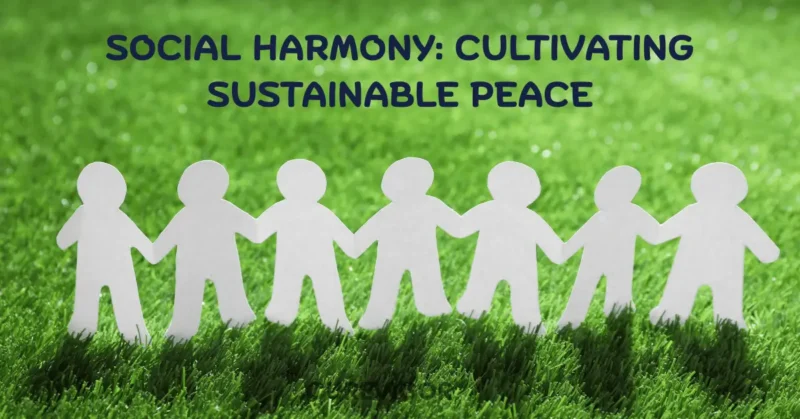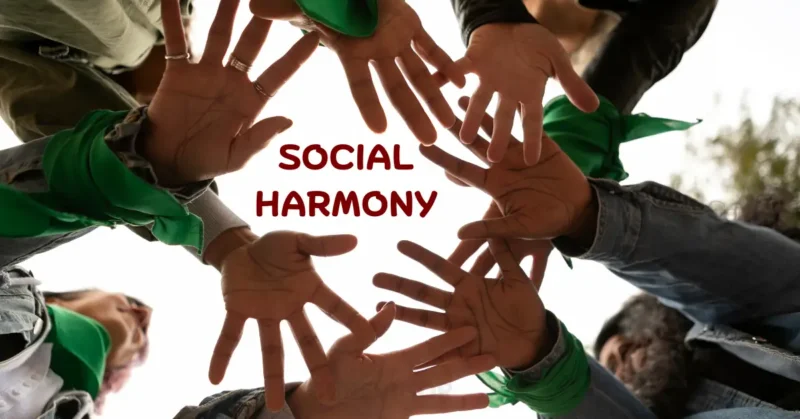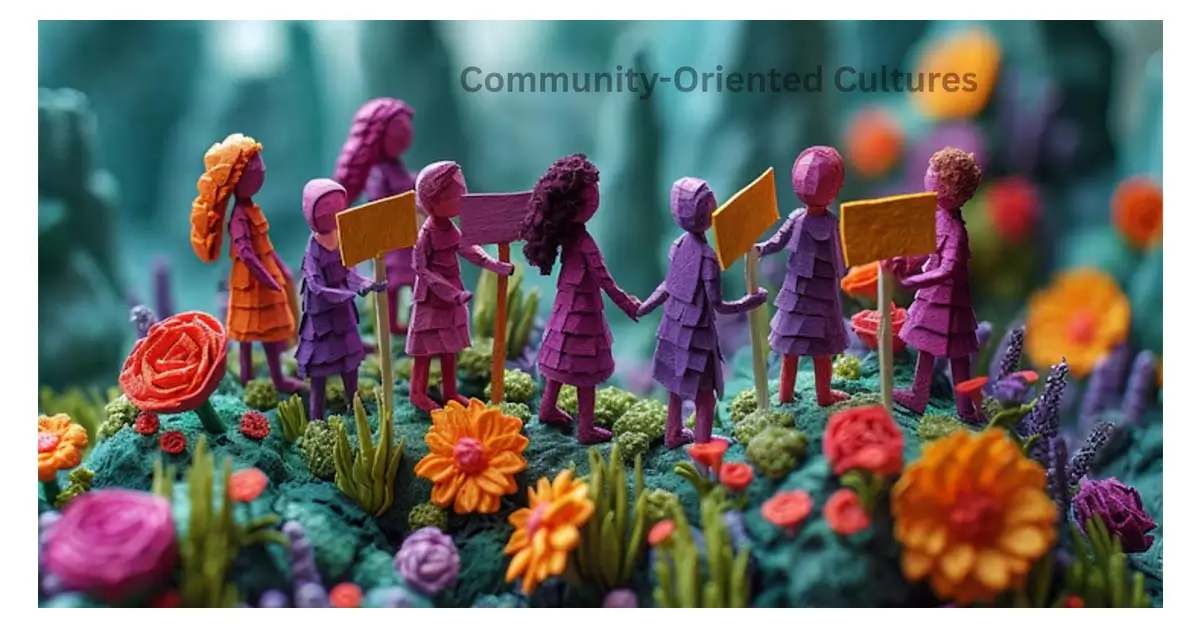Explore the essence of social harmony, its impact on community well-being, and how it fosters peace. Learn all you need to know about creating a harmonious society.
Thank you for reading this post, don't forget to subscribe!Social Harmony is the state where an individual’s social relationships are peaceful, cooperative, and supportive. This directly impacts and is a core measure of your Social Well-being.
Social Harmony: Principles, Benefits, and Practical Steps
In an increasingly interconnected world, social harmony has never been more critical. It’s a term that speaks to the very core of how we coexist, cooperate, and thrive as a community.
But what exactly is social harmony, and why is it vital for our collective well-being and peace? Let’s delve into the intricacies of this essential societal principle.
What is Social Harmony?
Social harmony refers to individuals’ balanced and peaceful coexistence within a community or society. It is characterized by mutual respect, understanding, and cooperation among diverse groups, enabling them to work together towards common goals.
Social harmony is not just the absence of conflict; it is the presence of positive interactions and relationships that promote a sense of belonging and collective identity.

Key Terms & Synonyms for Social Harmony
- Social cohesion
- Social unity
- Social concord
- Social balance
- Social integration
- Community Harmony
- Community peace
- Social tranquility
- Social equilibrium
- Social solidarity
The Core Benefits of Social Harmony
Social harmony within a community is vital to its well-being. Communities benefit greatly from social harmony, which raises the standard of living for all its members. Let’s explore these benefits in more detail:
Enhanced Cooperation
In a harmonious community, individuals and groups are more likely to collaborate and support one another. An understanding and mutual respect underpin this cooperation.
When people feel valued and heard, they are more inclined to work together towards common goals. Enhanced cooperation leads to:
- Effective Problem-Solving: Diverse perspectives and skills are pooled together, leading to more innovative solutions to community challenges.
- Collective Action: Coordinated efforts in community projects, environmental conservation, and social initiatives become more effective and impactful.
- Shared Resources: Communities can better manage and share resources, ensuring everyone’s needs are met without conflict.
Improved Mental Health & Lower Stress
A harmonious social environment significantly reduces stress and anxiety among community members. When individuals feel safe, respected, and included, their mental well-being is positively affected. It takes many different forms.
- Sense of Security: Knowing one is part of a supportive community alleviates fears and uncertainties.
- Belonging and Identity: Feeling connected to others fosters a sense of belonging, which is crucial for mental health.
- Reduced Isolation: Social harmony reduces feelings of loneliness and isolation, providing a supportive network for individuals to turn to in times of need.
Economic Growth & Stable Development
Communities that exhibit social harmony often enjoy higher economic activity and prosperity. Peaceful and cooperative interactions among community members create a conducive environment for economic growth. Key aspects include:
- Trade and Investment: A stable and harmonious community attracts businesses and investors, boosting local economies.
- Job Creation: Cooperative efforts and community-driven projects can lead to new job opportunities and entrepreneurial ventures.
- Economic Stability: With reduced conflicts and disruptions, communities can focus on sustainable economic development, ensuring long-term prosperity.
Social Cohesion
Strong bonds between community members enhance social networks, providing a robust support system. Social cohesion, a direct outcome of social harmony, has several benefits:
- Support Systems: In times of personal or collective crisis, a cohesive community offers robust support to those in need, fostering resilience.
- Collective Identity: A sense of shared identity and purpose strengthens community bonds, making members more likely to look out for one another.
- Increased Participation: Community members are more likely to participate in civic activities, volunteer efforts, and local governance, contributing to a vibrant and engaged society.
Social harmony is essential for the overall well-being of any community. It enhances cooperation, improves mental health, boosts economic growth, and strengthens social cohesion.
By fostering an environment of mutual respect and understanding, communities can thrive together, ensuring all members enjoy a higher quality of life. Embracing and nurturing social harmony is critical to building resilient, prosperous, and inclusive communities.
Cultivating Sustainable Peace Through Harmony

Peace and social harmony are closely related yet distinct concepts. While peace typically refers to the absence of conflict and violence, social harmony emphasizes positive social interactions and relationships.
Social harmony creates a foundation for peace by fostering an environment where individuals and groups can coexist and thrive. Here are some ways in which social harmony fosters peace:
Conflict Prevention
Social harmony plays a crucial role in preventing conflicts from arising in the first place. By promoting understanding and respect among diverse groups, social harmony reduces the likelihood of conflicts rooted in misunderstandings or prejudice. Key elements include:
- Education and Awareness: Promoting cultural awareness and tolerance through education helps dispel myths and stereotypes that can lead to conflict.
- Intergroup Dialogue: Facilitating open and respectful communication between different groups encourages mutual understanding and empathy.
- Inclusivity Policies: Implementing inclusive policies that ensure all community members feel valued and represented helps prevent feelings of marginalization that can lead to discord.
Conflict Resolution
In a harmonious society, conflicts are more likely to be resolved through dialogue and cooperation than violence. Social harmony fosters an environment where individuals and groups are more willing to engage in constructive conflict resolution. By doing so, we can:
- Mediation and Negotiation: Harmonious communities often have mechanisms for mediating disputes and negotiating solutions acceptable to all parties involved.
- Community Involvement: Active involvement in conflict resolution ensures that solutions are more widely accepted and respected.
- Restorative Practices: Emphasizing restorative justice approaches focusing on healing and reconciliation rather than punishment.
Sustainable Peace
Social harmony lays the groundwork for long-term peace by addressing the root causes of conflict and fostering an inclusive and supportive environment. Sustainable peace is achieved through:
- Economic and Social Equity: Ensuring equitable access to resources and opportunities reduces the economic and social disparities that often fuel conflict.
- Strong Social Networks: Building robust social networks that provide support and solidarity helps communities withstand and recover from conflicts.
- Ongoing Dialogue: Maintaining continuous and open communication channels helps address emerging issues before they escalate into more significant conflicts.
- Empowerment and Participation: Empowering all community members to participate in decision-making fosters a sense of ownership and commitment to peace.
Peace and social harmony are deeply interconnected, providing the foundation for lasting peace.
By fostering an environment of mutual respect, understanding, and cooperation, social harmony helps prevent conflicts, resolve existing ones peacefully, and ensures the sustainability of peace.
Building and maintaining social harmony is essential for creating communities where individuals can live peacefully and prosperously. Embracing these principles can lead to a more harmonious and peaceful world.
The Role of Social Harmony in Daily Interactions
Social harmony is fundamental to promoting positive relationships and interactions in a community setting. Being socially harmonious means embracing diversity, showing compassion for others, and respecting different perspectives and viewpoints.
Social harmony produces an environment that is conducive to safe engagement with others without being subjected to discrimination or hostility.
It motivates the community members to be more active in their community life, develop social relations and friendships, and build mutual support networks.
In a harmonious society, people will feel more connected, which leads to better mental health and a sense of belonging.
When social harmony is emphasized, collaboration, sharing ideas, and contribution toward every member’s goals become more likely. It creates a cycle of trust, cooperation, and shared responsibility in which everyone keeps the entire community safe and peaceful.
Promoting social harmony aids a community in providing this kind of unity, making its members thrive together and overcome their differences for everyday purposes.
Real-World Examples of Social Harmony in Action
Social harmony can be practiced in our everyday lives and communities. For instance, these include:
- Multicultural Celebrations: In many countries, cultural festivals bring people of different ethnicities, religions, and backgrounds together. Events like Diwali, Christmas, Eid, and Chinese New Year are often celebrated across communities, regardless of individual beliefs. It promotes mutual respect and appreciation for diversity.
- Inclusive Education Systems: Schools that focus on inclusive education foster social harmony by teaching children the values of empathy, equality, and cooperation. They provide an environment where students from diverse backgrounds can learn and grow together, developing a sense of respect for one another’s differences.
- Community Service Projects: Volunteering and community service projects, like charity events or neighborhood clean-ups, are excellent instances of social peace in action. These events inspire people from all walks of life to unite, strive for a common objective, and promote the general welfare of their society.
- Interfaith Dialogues: Interfaith organizations host gatherings and conversations in many communities to promote unity and religious sharing among individuals of various faiths. It lessens religious tensions, fosters understanding, and dismantles barriers.
- Workplace Diversity Programs: Businesses encouraging diversity and inclusion foster peaceful workplaces where workers from various backgrounds feel appreciated. When individuals with different backgrounds collaborate to achieve common business objectives, these initiatives frequently increase productivity, creativity, and teamwork.
- Local Peacebuilding Initiatives: Local governments or non-governmental organizations (NGOs) frequently oversee peacebuilding initiatives that entail communication, rapprochement, and cooperative problem-solving in places where conflicts exist between various groups.
These programs illustrate how social harmony can be preserved and rebuilt in areas prone to violence.
These illustrations demonstrate how social harmony may be woven into society’s foundation to build inclusive, resilient, and tranquil communities.
Building Social Harmony: Practical Steps & Best Practices
Achieving social harmony requires concerted efforts at both the individual and collective levels. It involves creating an environment where all community members feel valued, respected, and included. Here are some practical steps to build a harmonious society:
Promote Inclusivity
Social harmony depends on all community members feeling valued and included, regardless of their background. There are several ways to achieve this:
- Inclusive Policies: Develop and implement policies that promote equality and prevent discrimination. This includes laws and regulations that protect the rights of minority groups and ensure equal opportunities for all.
- Representation: Ensure diverse representation in community leadership, decision-making bodies, and public institutions. This will give all groups a voice and foster a sense of belonging.
- Accessible Services: Provide community services and resources that are accessible to everyone, including those with disabilities and those from disadvantaged backgrounds.
Encourage Dialogue & Active Listening
Facilitating open and respectful communication between diverse groups is essential for building mutual understanding and cooperation. Here’s how to encourage dialogue:
- Community Forums: Organize regular community forums to discuss issues, share perspectives, and find common ground. These forums can be moderated to ensure respectful and constructive conversations.
- Cultural Exchange Programs: Implement programs encouraging people from different cultural backgrounds to share their traditions, foods, arts, and customs. This will promote appreciation and reduce prejudice.
- Dialogue Initiatives: Launch initiatives that bring together members of conflicting groups to discuss their differences and work towards reconciliation. Trained mediators can facilitate these discussions to ensure they remain productive.

Educate for Harmony
Incorporating values of empathy, respect, and cooperation into educational curricula is crucial for fostering a culture of harmony and peace from a young age. Steps to achieve this include:
- Curriculum Development: Design educational programs that teach children about diversity, empathy, and conflict resolution. Include stories and examples that highlight the benefits of social harmony.
- Empathy Training: As a result, individuals can understand and respect the feelings and perspectives of others.
- Conflict Resolution Education: Teach students practical skills for resolving conflicts peacefully. Role-playing exercises and peer mediation programs can be helpful tools.
Support Community Activities
Encouraging participation in community events and activities helps build connections and strengthen the social fabric. Practical ways to support community activities include:
- Organize Events: Plan and host events such as festivals, sports competitions, and cultural celebrations that unite people. These events provide opportunities for social interaction and bonding.
- Volunteer Programs: Create and promote volunteer programs encouraging community members to work together on projects like neighborhood clean-ups, tree planting, or helping those in need. Volunteering fosters a sense of community and shared purpose.
- Support Local Initiatives: Provide funding and resources for local initiatives that improve community well-being. These include after-school programs, community gardens, and arts activities. Building social harmony is a multifaceted effort requiring individual, community, and institutional commitment.
We can create environments where all members feel valued and connected by promoting inclusivity, encouraging dialogue, educating for harmony, and supporting community activities.
These practical steps not only foster a harmonious society but also contribute to the overall well-being and prosperity of the community. Embracing and implementing these strategies can pave the way for a more inclusive, understanding, and peaceful world.
Frequently Asked Questions (FAQs) on Social Harmony
Q. What is the concept of social Harmony?
Social Harmony is a state characterized by peace between people or groups in a social setting. It encourages mutual respect, understanding, and cooperation among people of different backgrounds to work toward improving the community, where everyone finds value and importance.
Thus, extending beyond the absence of conflict with a positive approach is meant to build collaborative relationships to achieve better well-being for the entire community.
Q. What is social Harmony?
Fundamental principles of social Harmony include;
Mutual respect is the appreciation for cultural, opinionated, and belief differences.
- Inclusivity: Making everyone feel welcome and included without showing any bias in viewpoint or identity.
- Cooperation means creating cooperation and achieving desirable intentions through collaborative efforts.
- Conflict Resolution: The peaceful resolution of disagreement through dialogue and understanding.
- Empathy: The emotional expression shared to further social bonds.
- Peaceful Coexistence: Harmonious coexistence with others, away from violence and with mutual understanding.
Q. What are the essential elements of social Harmony?
The essential elements of social Harmony are:
- Respect for Diversity: Respect and appreciation of the difference in ethnicity, religion, culture, and points of view.
- Social Equity: Equal opportunities and just treatment for all individuals in a community.
- Peaceful Interaction: Encouraging non-violent communication and cooperation.
- Solidarity: Building strong social bonds that support collective action and mutual support.
- Active Participation: Community involvement in a decision-making process and civic activity.
Q. Why is Social Harmony Important?
There are various reasons why a harmonious society is crucial for a community.
- Promotes Peace: Conflicts and violence are controlled as they grasp and act cohesively.
- Promotes Well-being: The members’ mental health, security, and happiness will also rise.
- Economic Development: Such societies create a stable environment where economic development and trade flourish.
- Stronger Communities: It fosters cohesion, making communities more robust and supportive whenever trouble arises.
Cultural Exchange facilitates sharing ideas and cultures, enriching the community’s social fabric.
Q. What are the seven principles of Harmony?
Generally, the seven principles of Harmony commonly refer to the fundamental values that define harmonious relationships and society. They are
- Respect: Showing respect for others’ dignity and rights.
- Understanding: Gaining knowledge concerning others’ perspectives and experiences.
- Compassion: Care for and understanding of others.
- Tolerance: Tolerance toward other people’s dissimilar thoughts and means of living for mutual existence.
- Equity: Distribution of means and opportunities equally and rightly.
- Cooperation: Working together for the same goal
- Peace: Producing a non-violent, supportive environment whereby all can live and grow
Q. What are the three aspects of Harmony?
The three primary aspects of social Harmony can be defined as
- Emotional Harmony: the positive bonding and creation of relationships and communities when emotional energies such as empathy, compassion, and mutual supportive energy tie people together.
- Social Harmony: living in peace with each other’s needs and entitlements, inclusiveness, and respectful interaction between diverse groups.
- Structural Harmony: ensuring that systems and institutions are fair, just, and supportive of equality, providing a balanced and well-working society.
Conclusion: Social Harmony as a Core Community Value
Social harmony isn’t a passive state of quietness; it’s an active, daily practice built on the pillars of mutual respect and collective well-being. As we navigate an increasingly fragmented world, the lessons from community-oriented cultures—that peace is a strategy for progress, not just an aspiration—are more vital than ever.
You now know the practical benefits, from stronger mental health to stable economic growth, are tangible returns on an investment in social cohesion. The question isn’t whether we can achieve it, but how we maintain it. Ready to explore the deeper foundation?
See how these principles translate into daily life by reading our companion piece on Mutual Respect as a Cultural Norm.
Get more Health and Wellness Tips.
You might like to read:


